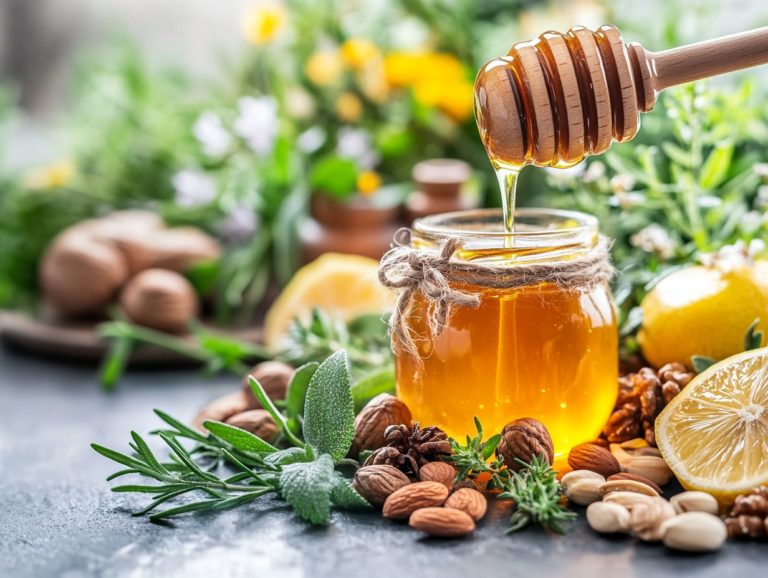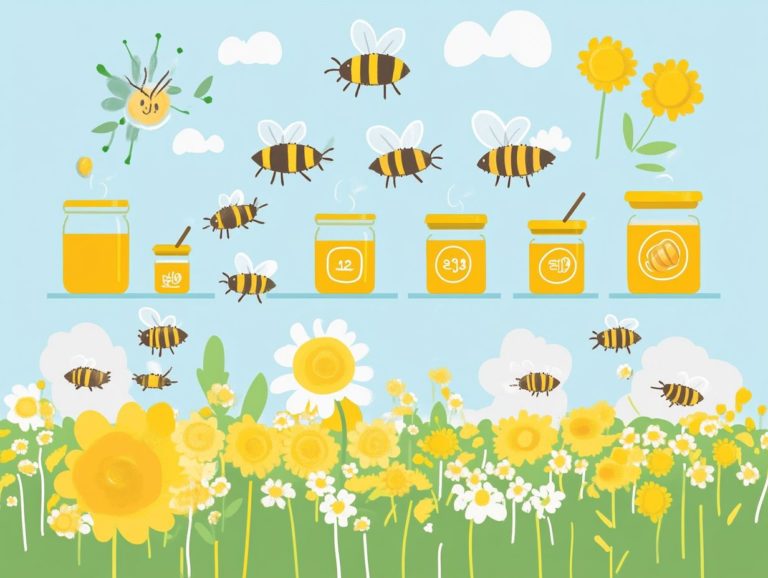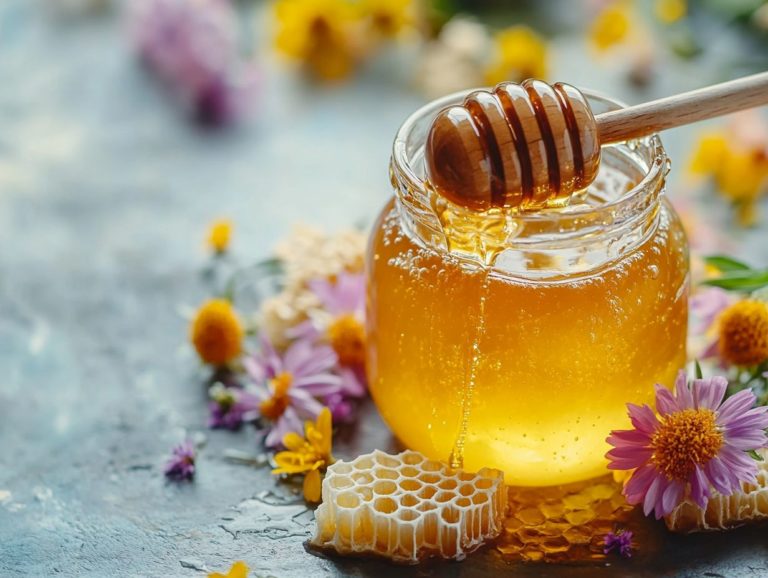The Role of Bees in Honey Production
Bees play a vital role in honey production, skillfully transforming nectar into the delightful, golden sweet substance you cherish.
Join us as we dive into the exciting journey of bees, from their meticulous gathering of nectar and pollen to the intricate processes occurring within the hive that culminate in how they make honey.
You ll uncover the various factors influencing honey production, including climate, flower availability, and the health of the bees themselves.
You’ll also learn about the honey extraction methods employed and the significant benefits that honey production provides, as well as the threats these essential pollinators face.
Get ready to explore the amazing world of bees and appreciate their crucial contributions to our ecosystem and economy, as well as the bee-friendly gardens that support them.
Contents
Key Takeaways:
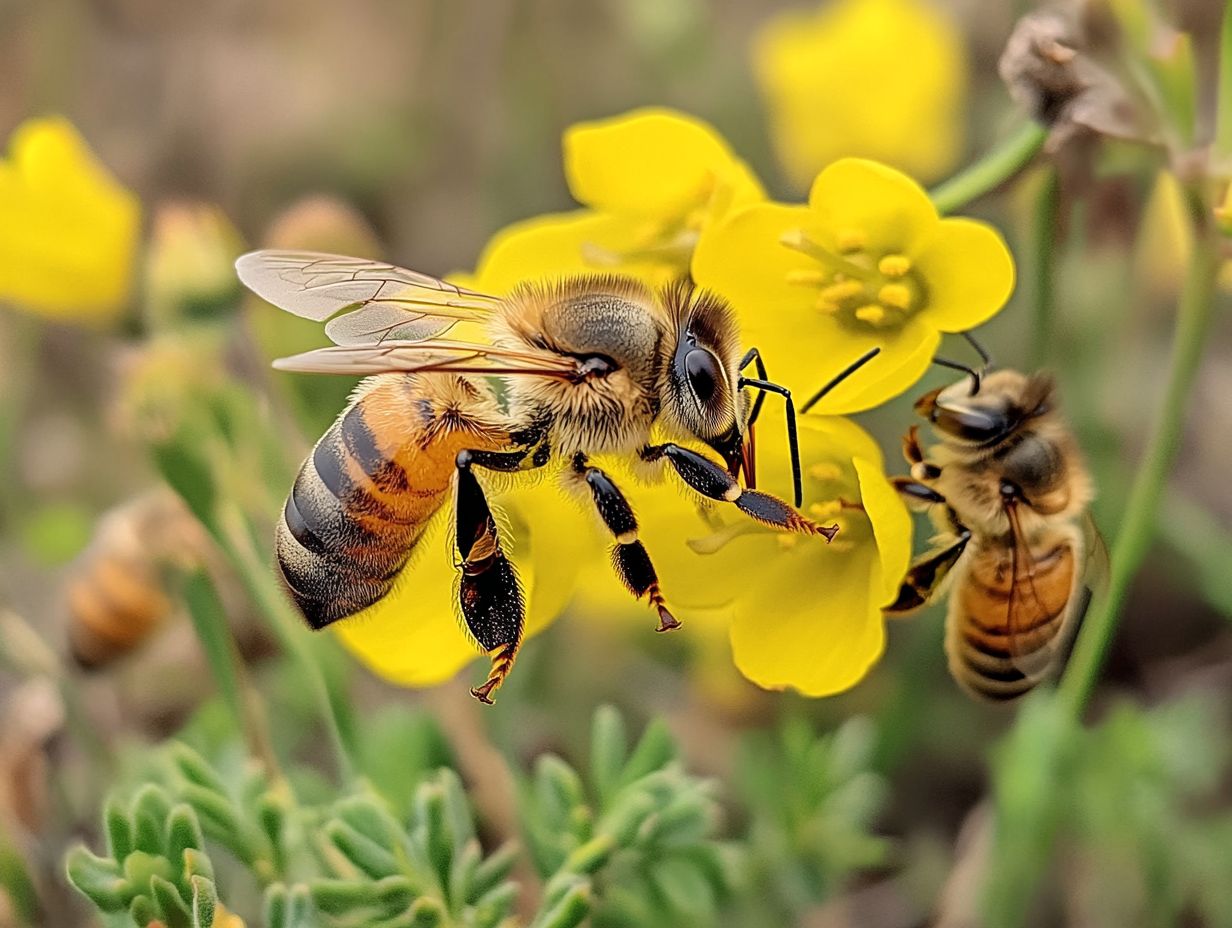
- Bees play a crucial role in honey production through their collection and processing of nectar and pollen, creating various honey types.
- Factors such as climate, availability of flowers, and colony health greatly impact the quantity and quality of honey produced.
- Honey production by bees provides environmental, economic, and health benefits, making it a valuable industry.
What Is the Role of Bees in Honey Production?
Bees play a vital role in honey production, serving as nature’s essential pollinators. The honey bees diligently collect nectar and pollen from a wide array of flowering plants. This foraging behavior does more than just facilitate the pollination of countless crops and wildflowers; it also supports the sustainability of entire ecosystems.
As these busy bees gather nectar, they transform it into honey a delightful substance brimming with carbohydrates, enzymes, and nutrients stored meticulously in honeycomb cells within the hive. The overall health of the bee colony directly influences honey production and, by extension, the agricultural economy as a whole.
How Do Bees Collect Nectar and Pollen?
Bees engage in fascinating foraging behavior, collecting nectar and pollen, which are vital for honey production and bee pollination.
These remarkable insects display intricate foraging patterns, often flitting between various flowers that provide plentiful nectar and suitable pollen. Each bee species, from honey bees to bumblebees, has its own unique floral preferences that inform their foraging routes, which is a critical aspect of bee communication.
As they embark on these journeys, bees rely on their sensitive antennae to pick up floral scents, ensuring they are attracted to the blossoms that yield the richest nectar. Once they ve gathered the nectar, they store it in their honey stomach a specialized organ that allows them to transport it back to the hive. This process sustains them and plays a critical role in transforming that nectar into honey through enzymatic actions, which are chemical processes that help convert nectar into honey.
What Happens Inside the Beehive?
Inside the beehive, you’ll find a fascinating social structure in action, where the queen bee, worker bees, and drones each play vital roles in maintaining the hive’s functionality and overall bee health.
Worker bees truly are the unsung heroes of the hive. They engage in a multitude of tasks, tirelessly gathering nectar and pollen, which are essential for honey production, creating a rich food source for the entire colony. Their dedication ensures that the hive remains productive and thrives.
The hexagonal cells of the honeycomb are not just clever storage for honey; they also serve as nurseries for the bee brood, showcasing an ingenious architectural design that maximizes space and efficiency. Maintaining the health of the hive is paramount, as a robust colony is better equipped to defend against hive pathogens and pests.
Ensuring that both honey storage and brood rearing can flourish ultimately secures the hive’s survival for generations to come.
How Do Bees Make Honey?
Bees create honey through a captivating process that involves collecting nectar, engaging in processing nectar with enzymes, and facilitating evaporation. This culminates in a sweet substance that delights the senses with its varied flavors and colors.
The journey begins when bees start by collecting nectar from blooming flowers, using their elongated proboscis to extract and store it in their specialized honey stomachs, which is a special stomach for storing nectar. Once they return to the hive, these industrious bees regurgitate the nectar and pass it on to other worker bees. These workers then mix the nectar with enzymes that break down the sugars, setting the stage for the next phase of transformation.
As the nectar mixture spreads throughout the hive, the water content diminishes through evaporation, a process aided by the bees fanning their wings to circulate air, ultimately influencing the honey color.
The sweet, golden honey you enjoy is shaped not only by the source of the nectar be it clover, wildflowers, or something more exotic but also by environmental factors like temperature and humidity. This interplay results in an array of flavors and colors, each reflecting the unique characteristics of the floral sources from which the nectar was harvested, creating distinct honey varieties.
What Factors Affect Honey Production?
Several critical factors play a pivotal role in honey production, including environmental conditions, the health of the bee colony, and the availability of floral resources. These elements profoundly impact honey yields, shaping both the quality and quantity of the final product you ultimately enjoy.
Climate and Weather
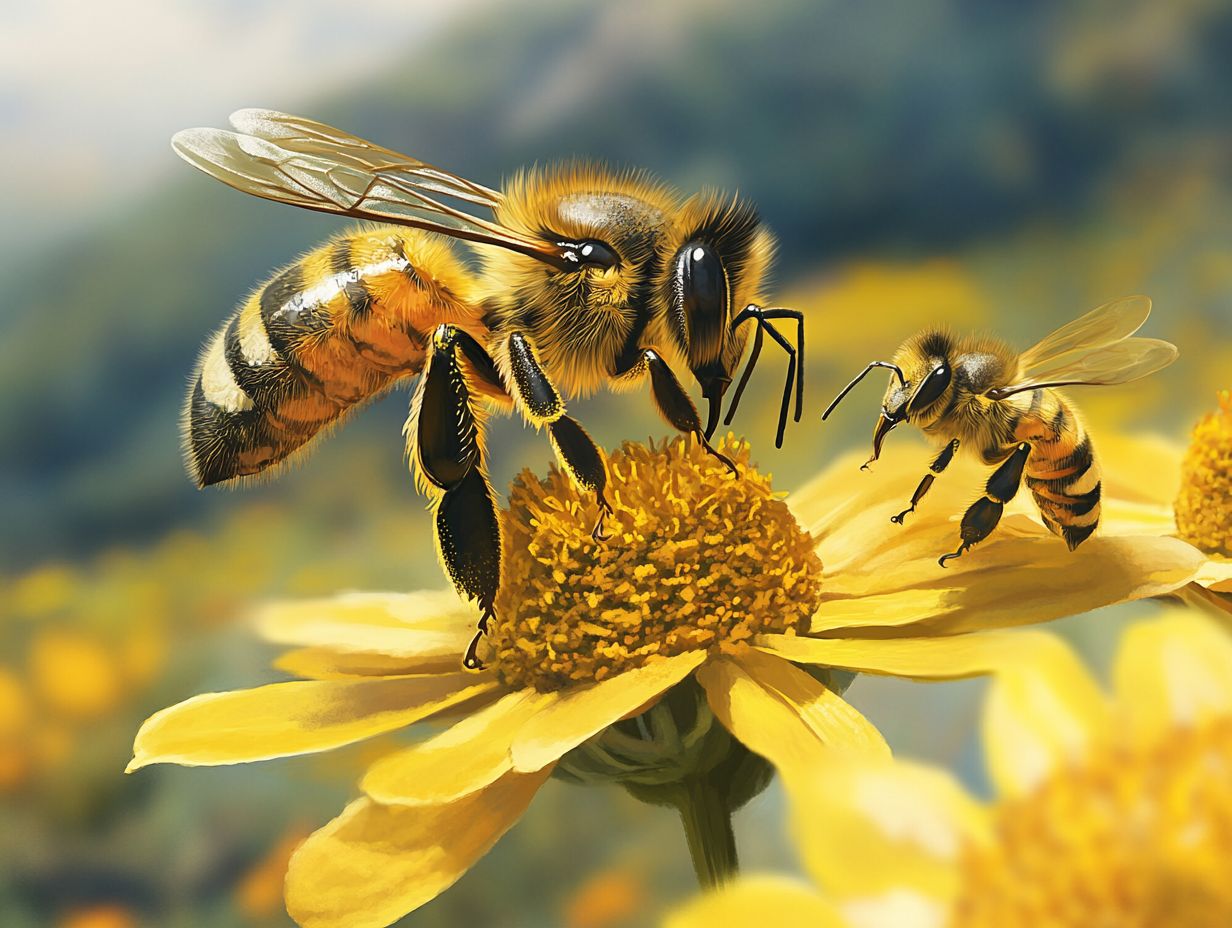
Climate and weather are crucial factors influencing the success of honey production. They directly impact both the foraging behavior of bees and the availability of nectar-rich flowers.
When temperatures fluctuate or rainfall patterns shift, you might notice flowers blooming earlier or later than expected. This can create a potential mismatch between flowering periods and bee activity. For example, a warmer spring could encourage flowers to pop up sooner. However, if bees are still dormant, those essential nectar sources become unreachable. Excessive rain can lead to flooding, which hampers the growth of flowering plants and diminishes their nectar output.
Extreme weather events such as droughts or severe storms can dramatically disrupt bee foraging patterns, resulting in lower honey yields and jeopardizing the delicate balance of pollination and food production.
Availability of Flowers and Plants
The availability of flowering plants is essential for honey bees. These plants serve as their primary sources of nectar and pollen, which are vital for honey production and the overall diet of the colony.
A diverse array of floral resources allows bees to collect a richer mix of nutrients, enhancing the honey flavor profile and boosting its nutritional quality. When bees forage from a variety of blossoms, they create distinct types of honey, each with its own unique colors, tastes, and health benefits.
The timing of flowering seasons significantly influences the foraging behavior of bees. As certain plants bloom, bees skillfully adapt their foraging strategies to maximize the available resources. This seasonal rhythm is crucial, ensuring that the colonies maintain a steady food supply, which is essential for their growth and sustainability, thus producing honey.
Health of the Bee Colony
The health of bee colonies is a crucial factor that directly influences honey production. Various threats jeopardize their survival and efficiency, such as colony collapse disorder.
Among these threats, colony collapse disorder stands out as a serious concern, causing hives to mysteriously dwindle. The presence of hive pathogens and parasites, like Varroa mites and Nosema disease, can weaken colonies, leaving them more susceptible to environmental stressors, which in turn affects honey production.
These challenges lead to lower honey yields and declining bee populations, which can have profound implications for ecosystems and agriculture. Protecting bee colonies is vital, not just for honey production, but for our entire ecosystem. Understanding and addressing these issues is essential for maintaining robust bee colonies and ensuring sustainable honey production for generations to come.
To support the health of bee colonies, consider getting involved in local conservation efforts or exploring different types of honey that celebrate this essential pollinator’s hard work.
How Is Honey Harvested?
Honey harvesting is a careful process that blends traditional methods with modern innovations. As you engage in this process, you’ll extract honey while prioritizing the health and sustainability of the bee colony, often relying on beekeepers’ expertise.
Traditional Honey Harvesting Methods
Traditional honey harvesting methods often rely on traditional methods that have been passed down through generations. This allows you to extract honey with care while preserving the integrity of the honeycomb structure and honeycomb cells.
Your journey begins as you don your protective gear, ensuring your safety around the buzzing hive. Typically, you ll open the hive after gently smoking the bees, which calms them and minimizes any aggressive behavior.
With the bees settled, you ll access the honeycomb frames, skillfully using a hive tool to pry them free without causing too much disturbance. The honey extraction process involves a delicate dance of uncapping (removing the wax seal from honey cells) and centrifugation (using a machine to separate honey from the comb), all aimed at preserving the fragile comb and the hive as a whole.
Throughout this meticulous process, it s essential for you to monitor and maintain the health of the bee colony. This ensures that the bees remain calm and their habitat undisturbed. By prioritizing the well-being of the bees, you can achieve a sustainable harvest while playing a vital role in supporting the overall ecosystem.
Modern Honey Harvesting Techniques
Modern honey harvesting techniques, particularly the use of Flow Hives, have transformed the way you extract honey. These methods enhance efficiency while minimizing any disturbance to your bees.
These innovative systems enable you to collect honey directly from the hive without disturbing the comb, a vital factor in maintaining the health of your colony. By simply turning a tap, honey flows effortlessly out while your bees go about their business undisturbed, preserving their natural environment.
This method not only streamlines the extraction process but also significantly reduces the stress that traditional harvesting methods can place on the colonies. You ll find that these technologies lead to quicker harvests and less labor-intensive procedures, making your beekeeping experience more enjoyable.
However, it s wise to keep in mind some potential drawbacks, such as the initial investment costs and the ongoing responsibility of ensuring the long-term health of your hives.
What Are the Benefits of Honey Production by Bees?
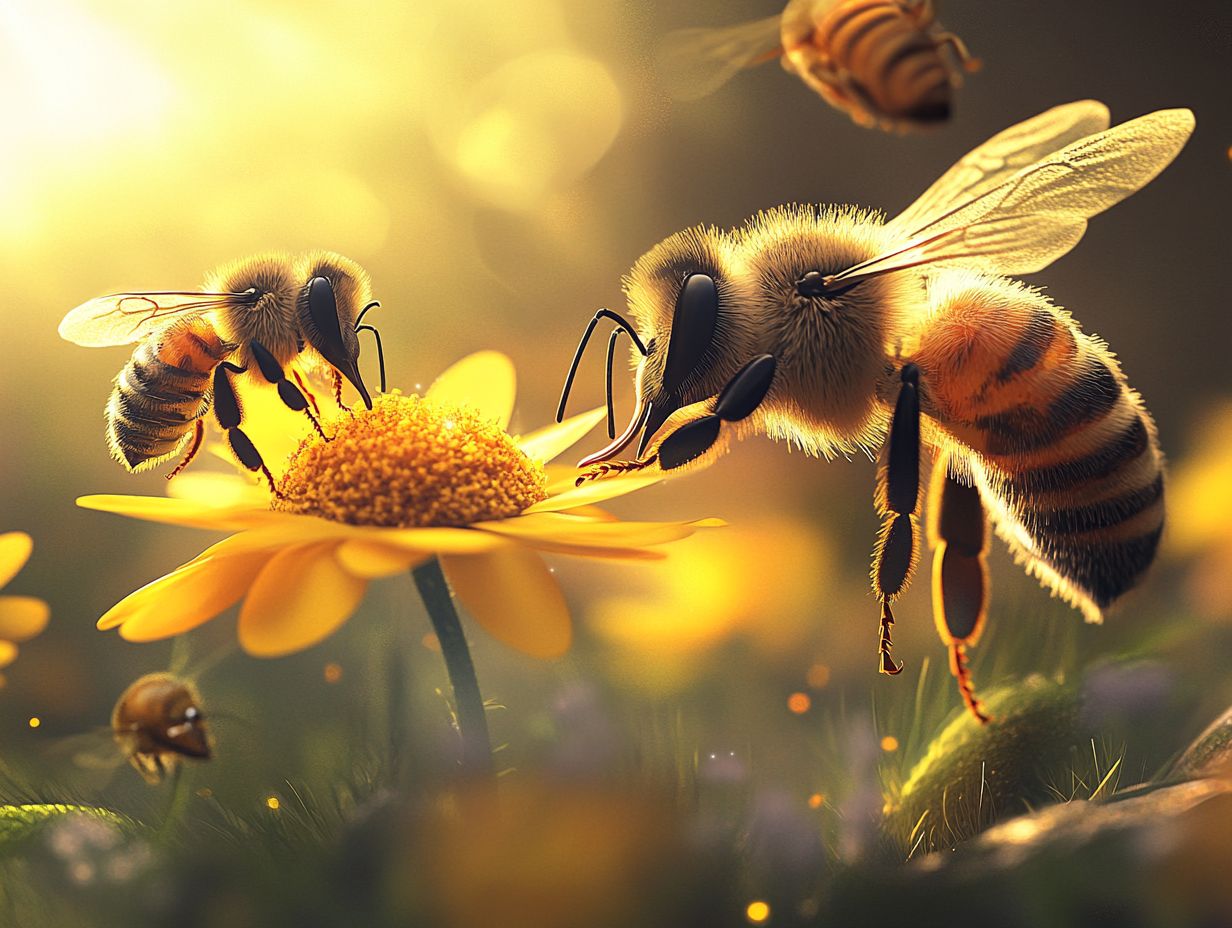
The production of honey by bees presents a wealth of advantages for you to appreciate. These industrious creatures play a crucial role in pollination, enhancing our environment. They also contribute significantly to the economy and offer remarkable health benefits associated with natural honey.
Environmental Benefits
The environmental benefits of honey production are truly remarkable. Bees play an essential role in pollinating flowering plants, which is a cornerstone for maintaining biodiversity.
Without their dedicated efforts, the crops you rely on for sustenance would experience significantly reduced yields. This could potentially lead to food scarcity and economic challenges.
This relationship shows just how vital bees are for our food supply and ecosystems. As bees diligently transfer pollen from flower to flower, they facilitate the reproduction of a diverse array of plants. This, in turn, supports varied habitats and food sources for countless organisms.
Therefore, sustaining bee populations is crucial; their decline could jeopardize not just crop availability but also the intricate web of life that hinges on these plants for survival. Acting now to protect bee populations is essential for our future food security and environmental health.
Join the movement to protect our bees and enjoy the sweet rewards of sustainable honey production!
Economic Benefits
Honey production plays a pivotal role in the agricultural economy. It significantly supports the livelihoods of beekeepers and enhances crop yields through efficient pollination.
This essential industry creates jobs in rural areas and stimulates growth in related sectors such as packaging and transportation.
As a beekeeper, you are integral to maintaining healthy bee populations, which are crucial for the successful reproduction of many fruit and vegetable crops. The financial benefits stemming from improved agricultural outputs due to bee pollination are evident in increased food diversity and higher market values for produce.
With consumers becoming more aware of the importance of pollinators, the demand for locally sourced honey and bee-related products is on the rise, further strengthening the economy tied to beekeeping.
Health Benefits
The health benefits of honey are well-documented. Natural honey offers essential nutrients, carbohydrates, and unique compounds like royal jelly that contribute to your overall wellness.
This golden elixir is delicious and packed with essential nutrients such as vitamins, minerals, and antioxidants, making it a valuable addition to your balanced diet.
Beyond its delightful sweetness, honey possesses remarkable antimicrobial properties. These can assist in wound healing and promote digestive health.
If you are in search of a natural sweetener, honey is often the go-to choice. It has a lower glycemic index compared to refined sugars, allowing for a more gradual release of energy.
Incorporating honey into your daily routine whether drizzled over your morning oatmeal or stirred into herbal teas can elevate your nutritional intake while adding a delightful burst of flavor.
What Are the Threats to Bees and Honey Production?
Bees face numerous threats that endanger their health and honey production. These struggles include exposure to harmful pesticides, various diseases, insidious parasites, and the alarming loss of their natural habitats.
Pesticides and Chemicals
The use of pesticides and chemicals in agriculture poses significant risks to bee health. These substances impact their ability to forage, reproduce, and ultimately produce honey.
Particularly concerning are neonicotinoids and glyphosate. These disrupt normal nervous system function, leading to impaired foraging behavior and weakened colonies.
These chemicals linger in the environment, accumulating in soil and water. They affect not only the immediate areas where they are applied but also broader ecosystems.
To mitigate these dangers, you can adopt natural methods to control pests. This includes employing natural predators and organic alternatives to reduce reliance on harmful substances.
Creating bee-friendly habitats and using cover crops can enhance biodiversity. This provides essential resources for pollinators and, in turn, supports resilient bee populations.
Parasites and Diseases
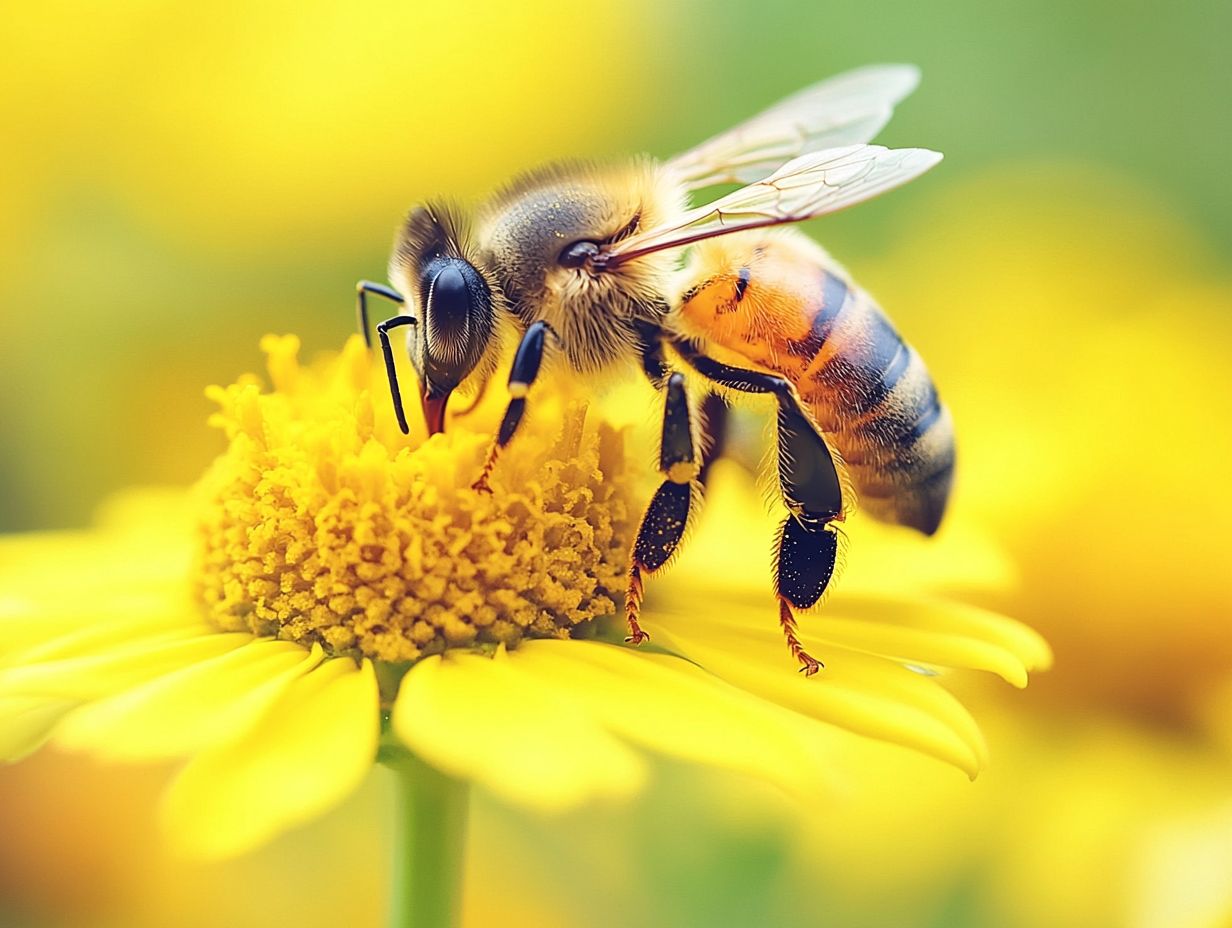
Parasites and diseases pose significant challenges to the health of your bee colonies. These issues result in colony losses and diminished honey production.
Among the most notorious offenders are Varroa mites, which latch onto bees and feed on their bodily fluids. They transmit harmful viruses that can wipe out entire colonies.
Another serious threat comes from Nosema, a fungal infection that wreaks havoc on the digestive systems of these insects. This leads to reduced foraging activity and overall weakness.
These health concerns highlight the critical need for you, as a beekeeper, to implement integrated pest management strategies. This includes conducting regular inspections, applying hive treatments, and ensuring strong genetics within your bee populations.
By staying proactive and well-informed about these threats, you can bolster the resilience of your colonies and promote a more sustainable beekeeping practice.
Take steps today to protect our bees!
Loss of Habitat and Food Sources
The loss of habitat and natural food sources due to urbanization and agricultural expansion poses a significant threat to bee populations and their ability to thrive. This damage to their homes restricts the foraging options available to bees. It also disrupts their essential pollination activities, which are vital for maintaining biodiversity and food production.
Without a variety of floral resources, bees struggle to gather the nutrients they need for survival. This results in reduced honey yields.
Various initiatives are underway to cultivate bee-friendly habitats. Community gardens, wildflower meadows, and urban green spaces are being developed to provide safe havens for bees, promoting their health while simultaneously supporting honey production and ecosystem stability.
These exciting efforts can help protect bees and secure our future!
Watch the video above to learn more about the importance of bees and how you can help!
Frequently Asked Questions
What is the role of bees in honey production?
Bees play a crucial role as the primary pollinators of flowers, which provide nectar for honey.
How do bees make honey?
Bees collect nectar from flowers and store it in their honey stomach. Once back at the hive, they transfer the nectar to other bees who then process and store it in the honeycomb to ripen into honey.
Why are bees important for honey production?
Bees are essential for honey production as they collect nectar and add enzymes and beneficial bacteria to it, transforming it into honey.
What other roles do bees play in honey production besides collecting nectar?
Bees also pollinate plants, which is essential for their growth and reproduction. This helps ensure a steady supply of nectar for honey production.
Are all bee species involved in honey production?
No, only honey bees, specifically the western honey bee (Apis mellifera), are commercially raised for honey production.
How much honey can a single bee produce in its lifetime?
A single bee can produce about 1/12 of a teaspoon of honey in its lifetime. However, as a collective, a hive of bees can produce up to 200 pounds of honey in a year.
Join local efforts to create bee-friendly environments!

